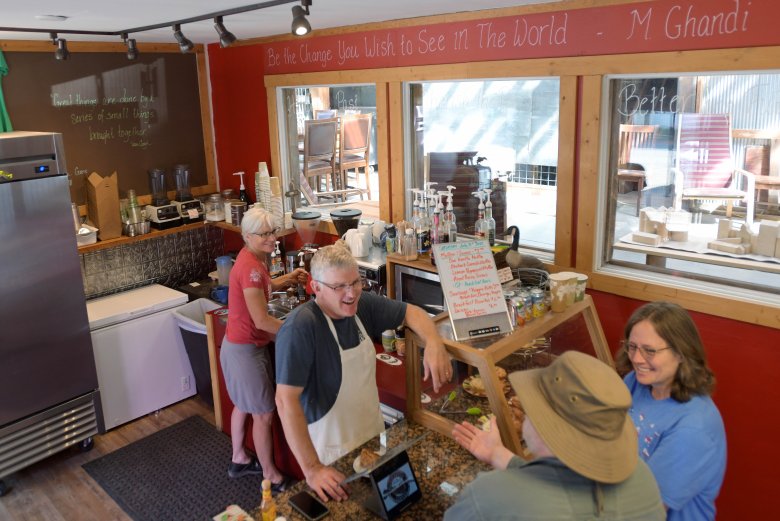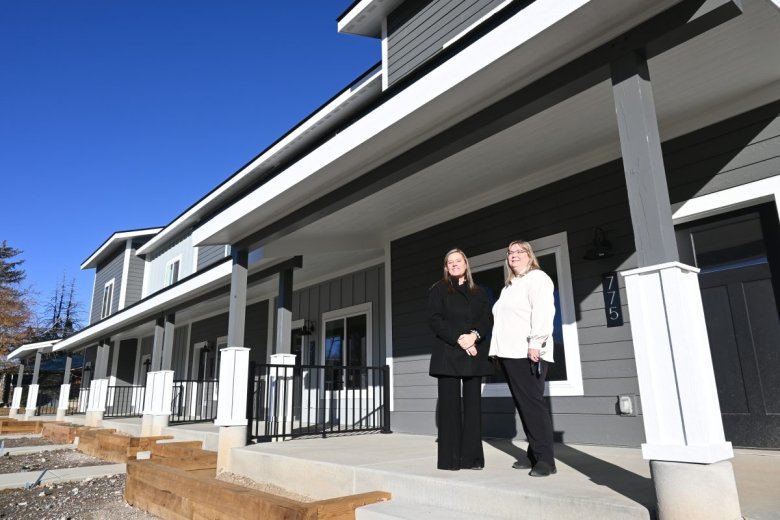In the second installment of KUNC’s series “Toxic waste or economic fuel” Scott Franz traveled west of Steamboat Springs, to coal country, where he found mixed feelings about the region’s economic future.
The northwest Colorado ranching community of Hayden is used to big sales pitches.
It’s been approached twice in the past by groups trying to sell them on casinos to solve their financial woes.
Now, residents in this small town on the Yampa River 25 miles west of Steamboat Springs are hearing about another big idea: importing toxic nuclear waste and creating the nation’s first centralized storage facility somewhere in the state’s northwest corner.
At this point, the idea is being floated in political circles, with lots of meetings and decisions pending. But the project is already raising eyebrows at the Wild Goose, a cozy coffee shop in the center of Hayden, next to the train tracks.
“Obviously, lots of concerns with transporting nuclear waste by rail,” Patrick Delaney, who owns the coffee shop with his wife, Tammie, said in November.
Tammie Delaney said the nuclear waste idea doesn’t fit with her town’s core values.
“And to me, it’s clean air, clean water,” she said. “Communities that know each other, that we know how to grow and raise our own food, and we know how to process it. We know how to create amazing baked goods.”
 Patrick and Tammie Delaney, owners of Wild Goose Coffee in Hayden, pictured July 31, 2021, opened the business in 2013. The coffee shop is in the town’s historic grain elevator, and it is the mission of the Delaneys to preserve the community gathering place in Northwest Colorado. (Matt Stensland, Special to The Colorado Sun)
Patrick and Tammie Delaney, owners of Wild Goose Coffee in Hayden, pictured July 31, 2021, opened the business in 2013. The coffee shop is in the town’s historic grain elevator, and it is the mission of the Delaneys to preserve the community gathering place in Northwest Colorado. (Matt Stensland, Special to The Colorado Sun)
This nuclear possibility comes in response to the shrinking economy here. Hayden has been losing coal jobs and its power plant is shutting down.
When KUNC visited this same coffee shop four years ago to talk to the Delaneys about life after coal, Tammie Delaney had lots of ideas for economic development, including reviving vintage auto races in the area.
Storing nuclear waste was not on her list.
But in recent months a regional economic development group called the Associated Governments of Northwest Colorado has accepted federal dollars and kicked off county-level conversations about a possible nuclear storage facility.
While Hayden’s leaders have been immediately skeptical and opposed to the prospect, some of its neighbors, including officials in Moffat County, want to continue exploring it.
Hayden’s leaders in Routt County haven’t been at the table. They actually quit the group floating the idea three years ago, citing differences over energy policy, among other issues.
“No political will”
Routt County Commissioner Tim Redmond is not on board with the nuclear waste storage talks.
“There is no political will in Routt County for a nuclear storage facility,” he said in November at Hayden’s newly opened community center.
He points to this vibrant facility, called the Hayden Center, as one of many signs the town can weather the coal transition without doing something like importing toxic waste.
On a Wednesday night in November, seniors’ spin classes, open-court basketball practice and a community hearing on a business development were all happening simultaneously at this facility.
Redmond said recent rail accidents are another reason to avoid the idea of importing radioactive material.
“I mean, we see what can happen with a crude oil train,” he said. “My God, what are we going to do with a nuclear waste accident?”
Redmond also points to new developments like a new business park going up at the Yampa Valley Regional Airport, as signs Hayden is doing just fine.
“If I look around at all the communities that are going through this transition, I think Hayden’s doing the best,” he said.
But Hayden can afford to be more selective about its economic future than its neighbors eyeing nuclear waste.
Here in Routt County, there’s a strong tourism industry and diverse economy centered in Steamboat Springs. Coal mining is responsible for less than fifteen percent of the county’s economic output.
Over in neighboring Moffat County, that number was almost 50% when the mines started closing
“So much, so fast”
Sasha Nelson projects a sense of urgency as she drives around the outskirts of Craig, in Moffat County, on a November afternoon to show off several projects designed to help this city weather a major economic transition away from its coal mines and power plants.
“We’re trying to do so much so fast,” said Nelson, a member of northwest Colorado’s Economic Recovery Corp.
 Sasha Nelson, right, poses with Shannon Scott, the economic development director for the city of Craig, at a new multifamily housing development in the city. Nelson said more than two dozen projects are underway to help the region transition away from coal revenue. (Scott Franz, KUNC)
Sasha Nelson, right, poses with Shannon Scott, the economic development director for the city of Craig, at a new multifamily housing development in the city. Nelson said more than two dozen projects are underway to help the region transition away from coal revenue. (Scott Franz, KUNC)
There are more than two dozen of the projects underway, Nelson said, ranging from a new affordable housing development in downtown Craig, to a commercial solar array on the outskirts of the city.
When they’re all done, Nelson said they will have 400 to 500 jobs replaced, and over $2 billion of capital invested into the region.
One of the projects already completed is a boat ramp that opened in May on the Yampa River at Craig’s Lowdy Simpson park.
Project leader Melanie Kilpatrick said it’s designed to attract hundreds of tourists.
“Others may spend time tubing (here) in lower season, others may come find a nice fishing hole,” she said. “Many, especially here in Moffat County, kind of want that wide open space and connection to nature.”
But how far will these projects go in replacing the coal revenue?
As Nelson continues the tour of the projects, she says none of this would be enough to replace the thousands of jobs that were projected to be in danger in the region when the mine and power plant closures were first announced in 2020.
That’s where nuclear waste storage comes back in. Nelson has heard about the idea but staring through the windshield of her SUV at the vast mesas and fields of sagebrush, she said she doesn’t want this region to become “a dumping ground.”
“It would break my heart, if, because of our remoteness, because of the space that we still have available, that that becomes a place where any project just ends, where we’re, you know, a waste disposal area,” she said.
But she said the talks are necessary for long-term economic development.
Nelson is focusing on what the region can do immediately to shore up the economy.
According to the federal government, even if northwestern Colorado puts in a bid for a nuclear waste storage facility, it would likely be a decade before it’s built.
Moffat County has hosted meetings about the idea of importing nuclear waste. A report the Associated Governments of Northwest Colorado wrote summarizing those meetings said there was “no notable fear” of continuing them in the region.
Political action on the idea could come soon.
More power
State Sen. Dylan Roberts represents Routt and Moffat counties at the statehouse. He’s interested in a waste storage facility, saying it could eventually help bring in nuclear power and research facilities. Roberts is a sponsor of House Bill 1040, which would add nuclear power to the definition of clean energy for purposes of utilities attempting to meet their greenhouse gas reduction goals in Colorado.
“I have been a strong supporter for things like the boat ramp and the affordable housing development in Craig, which are all going to help diversify their economy and keep people in the community, but we do need to recognize that a big part of their tax base is energy development, and it should continue to be that way,” he said.
Roberts said landing a waste storage facility would likely lead to a nuclear energy production facility as well.
“I would never want Craig or Moffat County or Rio Blanco County or the region as a whole to be perceived as just the place where nuclear waste goes,” he said. “But I think it could still be a very viable place for that, given the economic benefits of putting in a facility like that.”
Scott Franz reported this story for KUNC. It was first published on Jan. 21, 2025 and the audio version is available at KUNC.org.
Produced externally by an organization we trust to adhere to high journalistic standards.
